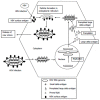Life cycle and pathogenesis of hepatitis D virus: A review
- PMID: 24409335
- PMCID: PMC3879688
- DOI: 10.4254/wjh.v5.i12.666
Life cycle and pathogenesis of hepatitis D virus: A review
Abstract
Hepatitis D virus (HDV) is a defective RNA virus which requires the help of hepatitis B virus (HBV) virus for its replication and assembly of new virions. HDV genome contains only one actively transcribed open reading frame which encodes for two isoforms of hepatitis delta antigen. Post-translational modifications of small and large delta antigens (S-HDAg and L-HDAg) involving phosphorylation and isoprenylation respectively confer these antigens their specific properties. S-HDAg is required for the initiation of the viral genome replication, whereas L-HDAg serves as a principal inhibitor of replication and is essential for the assembly of new virion particles. Immune mediation has usually been implicated in HDV-associated liver damage. The pathogenesis of HDV mainly involves interferon-α signaling inhibition, HDV-specific T-lymphocyte activation and cytokine responses, and tumor necrosis factor-alpha and nuclear factor kappa B signaling. Due to limited protein coding capacity, HDV makes use of host cellular proteins to accomplish their life cycle processes, including transcription, replication, post-transcriptional and translational modifications. This intimate host-pathogen interaction significantly alters cell proteome and is associated with an augmented expression of pro-inflammatory, growth and anti-apoptotic factors which explains severe necroinflammation and increased cell survival and an early progression to hepatocellular carcinoma in HDV patients. The understanding of the process of viral replication, HBV-HDV interactions, and etio-pathogenesis of the severe course of HDV infection is helpful in identifying the potential therapeutic targets in the virus life cycle for the prophylaxis and treatment of HDV infection and complications.
Keywords: Hepatitis B virus; Hepatitis D virus; Hepatitis D virus pathogenicity; Hepatitis delta antigens; Hepatocellular carcinoma; Host-pathogen interactions; Interferon-alpha; Virus replication.
Figures



Similar articles
-
Cellular Nuclear Export Factors TAP and Aly Are Required for HDAg-L-mediated Assembly of Hepatitis Delta Virus.J Biol Chem. 2016 Dec 9;291(50):26226-26238. doi: 10.1074/jbc.M116.754853. Epub 2016 Nov 2. J Biol Chem. 2016. PMID: 27807029 Free PMC article.
-
Hepatitis Delta Virus Alters the Autophagy Process To Promote Its Genome Replication.J Virol. 2020 Jan 31;94(4):e01936-19. doi: 10.1128/JVI.01936-19. Print 2020 Jan 31. J Virol. 2020. PMID: 31748400 Free PMC article.
-
Casein kinase II and protein kinase C modulate hepatitis delta virus RNA replication but not empty viral particle assembly.J Virol. 1996 Sep;70(9):6190-8. doi: 10.1128/JVI.70.9.6190-6198.1996. J Virol. 1996. PMID: 8709245 Free PMC article.
-
Future treatments for hepatitis delta virus infection.Liver Int. 2020 Feb;40 Suppl 1:54-60. doi: 10.1111/liv.14356. Liver Int. 2020. PMID: 32077603 Review.
-
An update on HDV: virology, pathogenesis and treatment.Antivir Ther. 2013;18(3 Pt B):541-8. doi: 10.3851/IMP2598. Epub 2013 Jun 21. Antivir Ther. 2013. PMID: 23792471 Review.
Cited by
-
Hepatitis B Virus Infection: A Mini Review.Viruses. 2024 May 3;16(5):724. doi: 10.3390/v16050724. Viruses. 2024. PMID: 38793606 Free PMC article. Review.
-
Impacts of Surface Characteristics and Dew Point on the Blue-Light (BL405) Inactivation of Viruses.Microorganisms. 2023 Oct 26;11(11):2638. doi: 10.3390/microorganisms11112638. Microorganisms. 2023. PMID: 38004651 Free PMC article.
-
Hepatitis Delta Infection: A Clinical Review.Semin Liver Dis. 2023 Aug;43(3):293-304. doi: 10.1055/a-2133-8614. Epub 2023 Jul 20. Semin Liver Dis. 2023. PMID: 37473778 Free PMC article. Review.
-
Non-organ-specific autoantibodies with unspecific patterns are a frequent para-infectious feature of chronic hepatitis D.Front Med (Lausanne). 2023 Jun 14;10:1169096. doi: 10.3389/fmed.2023.1169096. eCollection 2023. Front Med (Lausanne). 2023. PMID: 37387781 Free PMC article.
-
Management of hepatitis delta: Need for novel therapeutic options.World J Gastroenterol. 2015 Aug 28;21(32):9461-5. doi: 10.3748/wjg.v21.i32.9461. World J Gastroenterol. 2015. PMID: 26327754 Free PMC article. Review.
References
-
- Lai MM. Molecular biologic and pathogenetic analysis of hepatitis delta virus. J Hepatol. 1995;22:127–131. - PubMed
Publication types
LinkOut - more resources
Full Text Sources
Other Literature Sources

